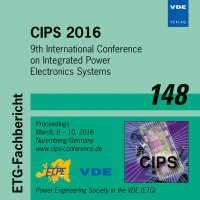Adjust the mechanical properties of sintered silver layers using additives
Conference: CIPS 2016 - 9th International Conference on Integrated Power Electronics Systems
03/08/2016 - 03/10/2016 at Nürnberg, Deutschland
Proceedings: CIPS 2016
Pages: 7Language: englishTyp: PDF
Personal VDE Members are entitled to a 10% discount on this title
Authors:
Wolfgang, Schmitt; Krebs, Thomas (Heraeus Deutschland GmbH & Co. KG, Germany)
Abstract:
Silver Sintering becomes mature as an interconnection technology for high reliability or high temperature electronics. Different sintering processes are applied depending upon application requirements, such as pressure sintering for power modules designed for elevated life time. The pressure of the sintering process can be adjusted in order to modify the properties of the sinter layer. Generally higher pressure / temperature leads to higher Young’s modulus. With respect to the lifetime of an interconnection, the Young’s modulus, the dimension of the connected area and the CTE mismatch of the joint materials are important factors in temperature cycling. Thermo-mechanical tension might not be lessened easily by the interconnect material if the Young’s modulus of the material is high. A brittle die attach material might crack due to the bending of the package forced by the CTE mismatch of the used materials. This leads to a degradation of thermal conductivity and a reduced life of the components, in particular on components which operate above 175 °C. To avoid cracks a low E-module is desired so that the bonding layer can follow the bending of the package. For sinter materials this can be achieved e.g. by an adjustment of sintering parameters. It´s evident, that Young’s modulus varies with applied process parameters, but it’s also known that low E-modulus can increase during thermal exposure. By hardening of the sinter layer the thermo-mechanical stress may potentially increase in the package. Looking to the above mentioned, an Ag sintering material providing a reduced Young’s modulus as well as an adjusted CTE would be beneficial, especially for the interconnection of large areas. This paper will show the intermediate result of the work done to reduce the Young’s modulus and the CTE of an Ag-sinter layer. By adding non silver particles to sinter paste E-module became independent of process parameters and became stable against further thermal exposure. The investigation is a part of the public project HHK funded by BMBF.


